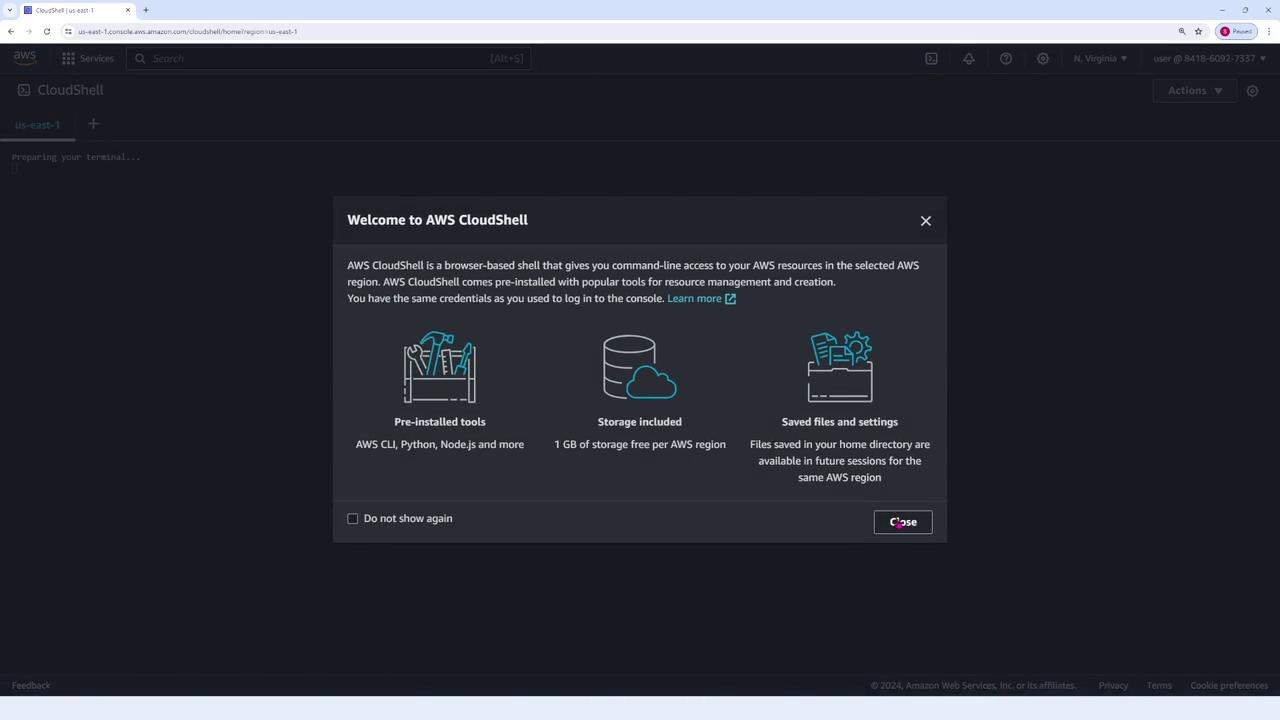AWS Certified Developer - Associate
AWS Fundamentals
AWS CloudShell Demo
In this guide, you'll learn how to quickly work with AWS CloudShell, a cloud-based terminal pre-configured with your AWS credentials. CloudShell enables you to start using the AWS CLI immediately—eliminating the need for local setup and manual credential management.
Getting Started with AWS CloudShell
Begin by searching for and launching the CloudShell service. Once open, you’ll see a terminal session similar to the welcome screen below:

Note
AWS CloudShell automatically configures your credentials, allowing you to use the AWS CLI without any additional setup.
Executing AWS CLI Commands
CloudShell’s pre-configuration makes it ideal for quick tasks. For example, to list your S3 buckets, run the following command:
aws s3 ls
This command returns output similar to:
2023-12-21 17:13:29 aws-cloudtrail-logs-841869027733-c209767c
2024-02-15 04:21:03 aws-sam-cli-managed-default-samclisourcebucket-bcsnuqjtiqks
2023-10-16 02:53:15 cdk-hnb659fds-assets-841869027733-us-east-1
2023-10-16 06:12:15 templates-ij5jauotfkzo-us-east-1
2023-10-10 21:23:10 codepipeline-us-east-1-239009679739
2023-10-12 23:27:32 config-bucket-841869027733
2023-10-12 22:19:24 elasticbeanstalk-us-east-1-841869027733
2024-04-14 21:50:40 kedloud.cloudfront-demo
Because CloudShell takes care of configuration, there is no need to manually manage credentials or install the AWS CLI.
Handling CLI Errors
If a command is entered with an invalid subcommand, the CLI will return an error message. For example, an incorrect invocation might yield:
aws: error: argument subcommand: Invalid choice, valid choices are:
ls | website
cp | mv
sync | rb
mb |
presign
This helpful feedback assists in correcting the command usage on the fly.
Example Session Workflow
A typical CloudShell session might involve listing S3 buckets, clearing the terminal, and viewing local directory contents. Here’s an example session:
Listing S3 Buckets
[cloudshell-user@ip-10-130-65-170 ~]$ aws s3 ls 2023-12-11 17:13:25 aws-cloudtrail-logs-841860927337-c209767 2022-02-15 21:18:30 aws-s3-all-managed-default-s3bucket-simlcusbucket-bcsmu3jiqxs 2023-10-16 22:18:00 cdk-hnb659fds-eu-west-1-<hash> 2023-10-10 20:14:37 config.bucket-<region>-us-east-1Clearing the Terminal
[cloudshell-user@ip-10-130-65-170 ~]$ clearListing Directory Contents
[cloudshell-user@ip-10-130-65-170 ~]$ ls aws-cloudtrail-logs-841860927337-ca296761 2023-10-16 22:18:00 elasticbeanstalk-us-west-1-841860927337 2024-10-14 20:40:20 kodeloud.cloudfront-demoReturning Prompt
The terminal finally returns control to the user:
[cloudshell-user@ip-10-130-65-170 ~]$
Summary
Using AWS CloudShell simplifies the process of working with the AWS CLI by eliminating setup overhead and manual configuration. This makes it an excellent tool for quick command-line tasks directly within your AWS environment.
Watch Video
Watch video content